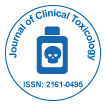
Journal of Clinical Toxicology
Open Access
ISSN: 2161-0495

ISSN: 2161-0495
Commentary - (2025)Volume 15, Issue 1
Toxins are biologically active substances produced by living organisms or introduced into ecosystems through synthetic processes. These substances are capable of causing a range of adverse effects in other organisms, including humans. They can be incredibly diverse in their origin, chemical structure and biological activity, making them a complex and critical subject of study in medicine, environmental science and public health. From natural toxins produced by bacteria, plants and animals to industrial pollutants and synthetic chemicals, toxins represent a persistent and often invisible threat to human health and environmental integrity.
Toxins are generally classified based on their source. Bacterial toxins, for instance, are divided into endotoxins and exotoxins. Endotoxins are part of the outer membrane of Gram-negative bacteria and are released when the bacteria die and disintegrate. They can provoke intense immune responses and are a major cause of septic shock and systemic inflammation. Exotoxins, by contrast, are secreted by living bacteria and tend to be highly potent. A classic example is botulinum toxin from Clostridium botulinum, which is considered the most lethal toxin known. Despite its danger, this toxin is used in minute, controlled doses for medical treatments such as muscle spasticity and cosmetic procedures like Botox.
Fungal and plant derived toxins also present significant public health concerns. Mycotoxins, toxic secondary metabolites produced by fungi such as Aspergillus, can contaminate staple food crops like maize, wheat and peanuts, particularly in tropical climates. Aflatoxins, one of the most studied mycotoxins, are carcinogenic and have been linked to liver cancer, immune suppression and malnutrition, particularly in low-income regions with inadequate food safety regulation. Ingestion of even small amounts over time can have cumulative health effects, especially in children. Similarly, toxic alkaloids found in plants like nightshade or hemlock have historically been used both medicinally and lethally.
Marine biotoxins are another category of natural toxins with severe implications. Produced by Harmful Algal Blooms (HABs), such as dinoflagellates, these toxins accumulate in shellfish and can cause life-threatening conditions like paralytic shellfish poisoning in humans. These blooms are often exacerbated by climate change and nutrient runoff, raising concerns about the increasing frequency and severity of toxin exposure in coastal populations.
In contrast to naturally occurring toxins, synthetic and environmental toxins are largely anthropogenic. These include Persistent Organic Pollutants (POPs) like Polychlorinated Biphenyls (PCBs) and dioxins, heavy metals such as mercury, arsenic and lead, and Endocrine-Disrupting Chemicals (EDCs) like Bisphenol A (BPA) and phthalates. These compounds are found in plastics, pesticides, cosmetics and industrial waste. Due to their ability to resist degradation, many of these toxins persist in the environment for decades, bioaccumulating in the food chain and magnifying their toxicity at higher trophic levels. They have been linked to developmental disorders, neurotoxicity, reproductive dysfunction and a range of cancers.
Modern toxicology and molecular biology have made great strides in understanding how these substances interact with the human body. Toxins can interfere with cell membranes, inhibit enzymes, disrupt DNA replication or mimic hormones. While the effects of acute exposure are often immediate and dramatic, chronic exposure to low levels of toxins may go unnoticed for years yet result in serious long-term health consequences. Vulnerable populations such as pregnant women, infants and the elderly are especially at risk due to weaker detoxification systems or increased physiological sensitivity.
In conclusion, toxins both natural and synthetic pose a serious threat to human health and environmental sustainability. While some toxins have therapeutic uses, the majority are hazardous and require robust management strategies. Continued scientific research, public awareness campaigns and international regulatory cooperation are essential to limit exposure and mitigate health impacts. With advancing detection technologies and greater global commitment to environmental stewardship, it is possible to protect both people and the planet from the silent and often overlooked dangers posed by toxins.
Citation: Mendes SK (2025). Toxic Exposures as Underestimated Drivers of Environmental and Public Health Risk. J Clin Toxicol. 15:585.
Received: 03-Jan-2025, Manuscript No. JCT-25-37436; Editor assigned: 06-Jan-2025, Pre QC No. JCT-25-37436 (PQ); Reviewed: 20-Jan-2025, QC No. JCT-25-37436; Revised: 27-Jan-2025, Manuscript No. JCT-25-37436 (R); Published: 06-Feb-2025 , DOI: 10.35841/0976-4860.25.15.585
Copyright: © 2025 Mendes SK. This is an open-access article distributed under the terms of the Creative Commons Attribution License, which permits unrestricted use, distribution, and reproduction in any medium, provided the original author and source are credited.